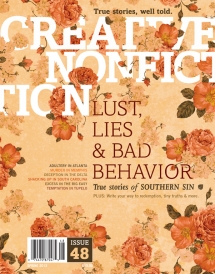 This will be a short post, because I’m going to share a link to a longer article that I hope you will take time to read. It’s called, “Salvage, Salvation, Salve: Writing That Heals,” by Pushcart Prize-winning author, Jennifer Lunden. It’s in Issue #48, the Spring 2013 issue of Creative Nonfiction.
This will be a short post, because I’m going to share a link to a longer article that I hope you will take time to read. It’s called, “Salvage, Salvation, Salve: Writing That Heals,” by Pushcart Prize-winning author, Jennifer Lunden. It’s in Issue #48, the Spring 2013 issue of Creative Nonfiction.
Whether you write for healing or for art (with or without publication in mind) Lunden—a therapist who suffers from chronic fatigue syndrome—says:
When we don’t express our difficult stories—the parts of our lives that trouble us in some way—they get frozen in our bodies…. Writing—or even telling—these stories helps to melt them, to dissolve their constricting power. When our experiences can flow through us, we can flow more easily through life.

I’ve found this to be true. Of the dozen or so essays I’ve had published in journals and anthologies, five of them talk about my own personal struggles. I didn’t write them as therapy. I wrote them as art. But I don’t think that these two kinds of writing must always be separate. In either case, we’ve got to explore the details in order to find healing and to produce good art. As Lunden continues:
In therapeutic writing, we are looking for the “thick story.” We are looking for the rich details that have been forgotten or ignored. We are searching for a broader perspective.
I’ve just begun another round of revisions on my novel. Working with an editor recommended by the agent who has shown interest in the book, I’m doing an exercise she recommended to help flesh out the three main characters more fully. (I might write more about this on Wednesday.) And even though it’s a novel and not a memoir, my own personal experiences certainly fuel the story. So, as I labor to give each of them a stronger, unique voice, maybe I will find my own voice more clearly. More wisdom from Lunden’s article:
When we are writing—whether toward therapeutic or literary ends—we must also look for the “thick story” of each of our characters. We have to make our characters multidimensional. In doing that, we can—we have to—forgive. We can—we have to—see the humanness of all people, even those who have harmed us. In the process of trying to write well, we must reach for our higher and better selves. In this way, we can heal the wounded places inside us.
Here’s to thickening up Mare, Elaine and Neema. And maybe even my own psyche.
Thank you for sharing this and best wishes as you “thicken” your character trio.
Because I am writing mostly poetry at this point, I am looking at your blog post and the linked article through that lens. I do often write poems using my own experience and find myself choosing one (or a small number of) detail that is most evocative. I try to leave enough mystery to invite the reader to put themselves into the situation of the poem or to recall a similar experience of their own.
Thanks for for your comment, Joanne. Good point about leaving enough mystery….